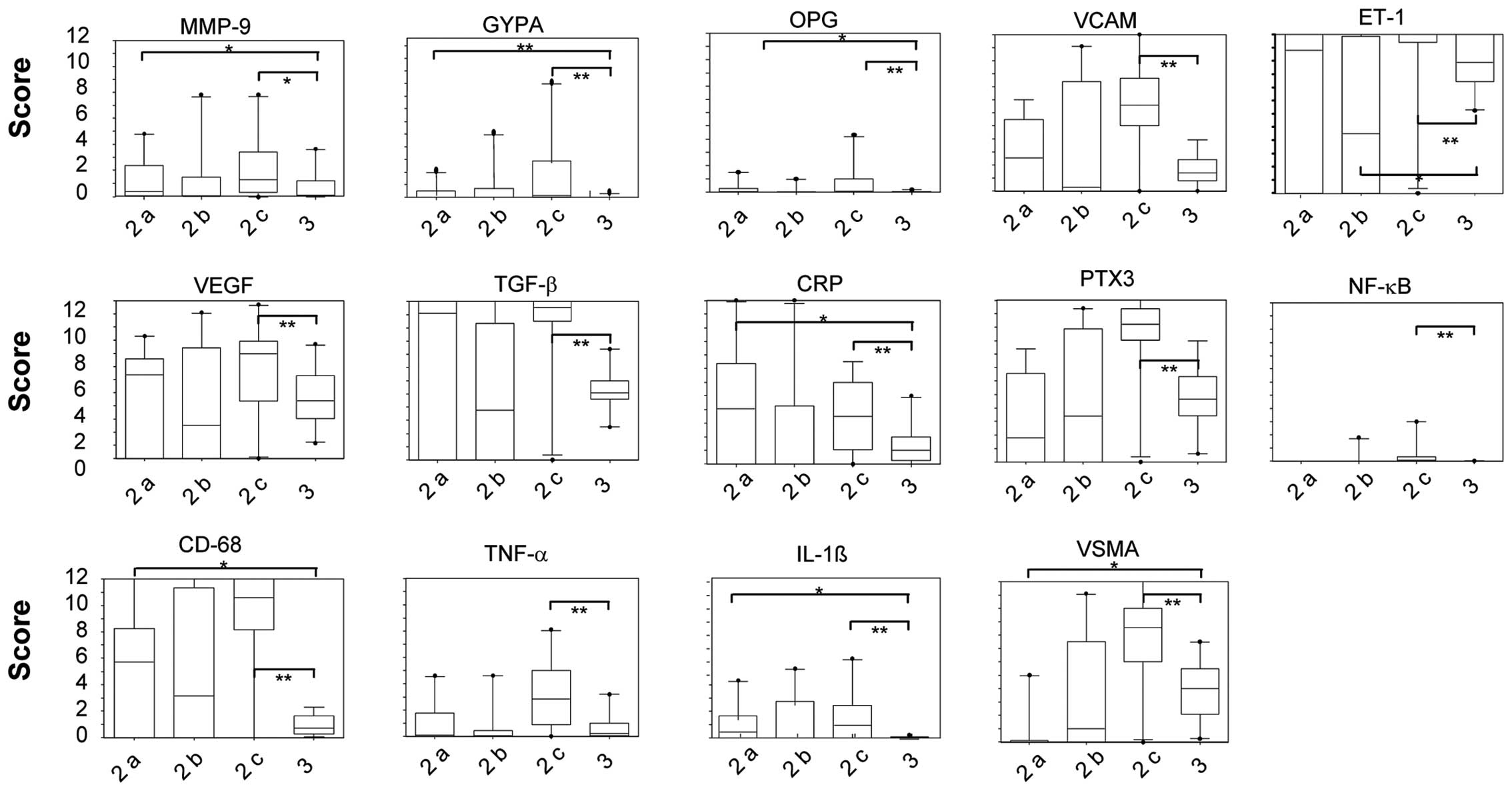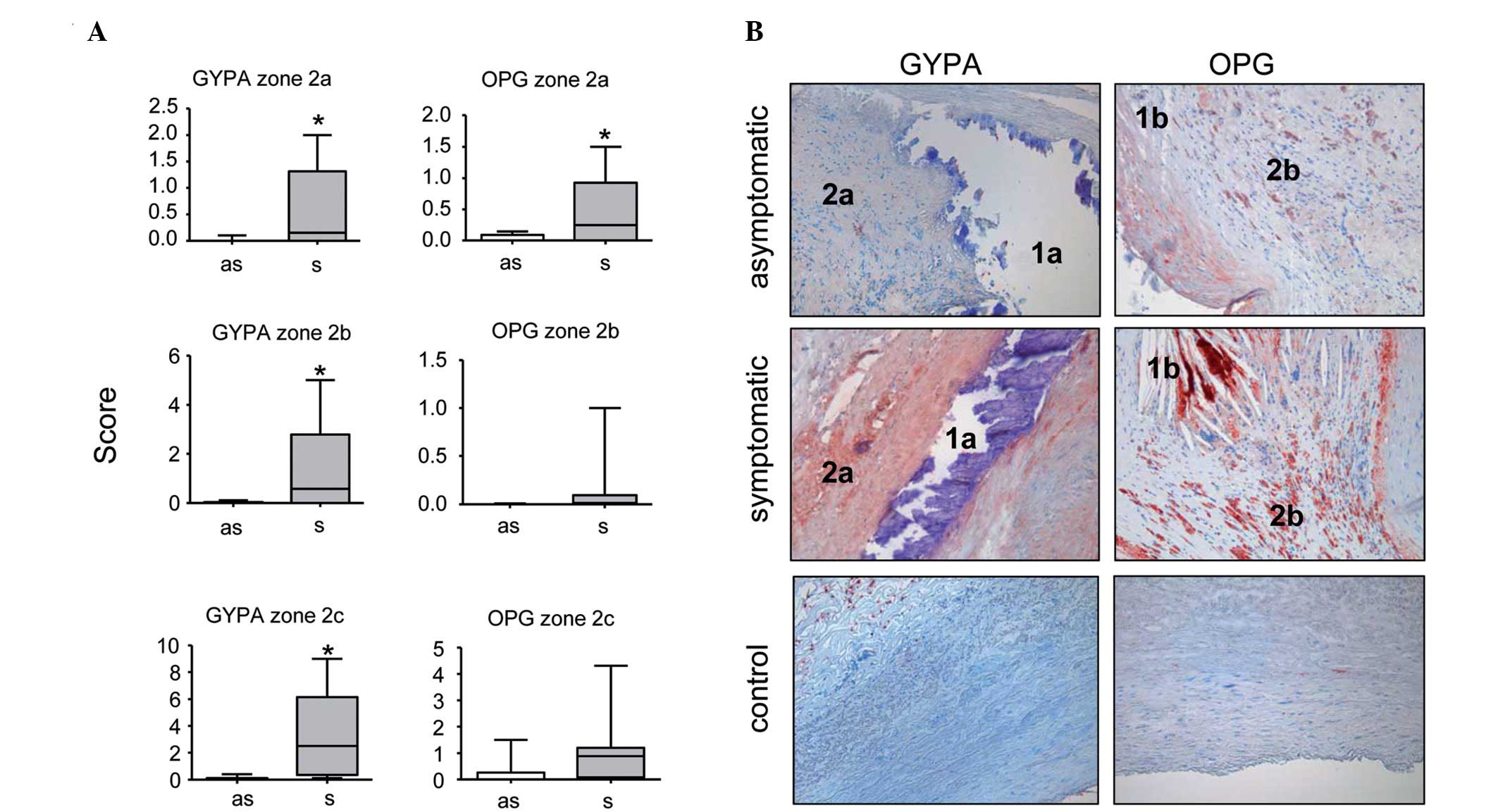|
1
|
Beneficial effect of carotid
endarterectomy in symptomatic patients with high-grade carotid
stenosis. North American Symptomatic Carotid Endarterectomy Trial
Collaborators. N Engl J Med. 325:445–453. 1991. View Article : Google Scholar : PubMed/NCBI
|
|
2
|
Halliday AW, Thomas DJ and Mansfield AO:
The asymptomatic carotid surgery trial (ACST). Int Angiol.
14:18–20. 1995.
|
|
3
|
Golledge J: Carotid intervention in
asymptomatic patients. Stroke. 39:e172008. View Article : Google Scholar
|
|
4
|
Mauriello A, Sangiorgi GM, Virmani R, et
al: A pathobiologic link between risk factors profile and
morphological markers of carotid instability. Atherosclerosis.
208:572–580. 2010. View Article : Google Scholar : PubMed/NCBI
|
|
5
|
Galis ZS, Sukhova GK, Lark MW and Libby P:
Increased expression of matrix metalloproteinases and matrix
degrading activity in vulnerable regions of human atherosclerotic
plaques. J Clin Invest. 94:2493–2503. 1994. View Article : Google Scholar
|
|
6
|
Galis ZS and Khatri JJ: Matrix
metalloproteinases in vascular remodeling and atherogenesis: the
good, the bad, and the ugly. Circ Res. 90:251–262. 2002.PubMed/NCBI
|
|
7
|
Kolodgie FD, Gold HK, Burke AP, et al:
Intraplaque hemorrhage and progression of coronary atheroma. N Engl
J Med. 349:2316–2325. 2003. View Article : Google Scholar : PubMed/NCBI
|
|
8
|
Abedin M, Omland T, Ueland T, et al:
Relation of osteoprotegerin to coronary calcium and aortic plaque
(from the Dallas Heart Study). Am J Cardiol. 99:513–518. 2007.
View Article : Google Scholar : PubMed/NCBI
|
|
9
|
Golledge J, McCann M, Mangan S, Lam A and
Karan M: Osteoprotegerin and osteopontin are expressed at high
concentrations within symptomatic carotid atherosclerosis. Stroke.
35:1636–1641. 2004. View Article : Google Scholar : PubMed/NCBI
|
|
10
|
Adams DH and Shaw S: Leucocyte-endothelial
interactions and regulation of leucocyte migration. Lancet.
343:831–836. 1994. View Article : Google Scholar : PubMed/NCBI
|
|
11
|
Ramana KV, Bhatnagar A and Srivastava SK:
Inhibition of aldose reductase attenuates TNF-alpha-induced
expression of adhesion molecules in endothelial cells. FASEB J.
18:1209–1218. 2004. View Article : Google Scholar : PubMed/NCBI
|
|
12
|
Bevilacqua MP: Endothelial-leukocyte
adhesion molecules. Annu Rev Immunol. 11:767–804. 1993. View Article : Google Scholar : PubMed/NCBI
|
|
13
|
Cybulsky MI and Gimbrone MA Jr:
Endothelial expression of a mononuclear leukocyte adhesion molecule
during atherogenesis. Science. 251:788–791. 1991. View Article : Google Scholar : PubMed/NCBI
|
|
14
|
Stephan CC and Brock TA: Vascular
endothelial growth factor, a multifunctional polypeptide. P R
Health Sci J. 15:169–178. 1996.PubMed/NCBI
|
|
15
|
O’Brien ER, Garvin MR, Dev R, et al:
Angiogenesis in human coronary atherosclerotic plaques. Am J
Pathol. 145:883–894. 1994.
|
|
16
|
Schiffrin EL and Touyz RM: Vascular
biology of endothelin. J Cardiovasc Pharmacol. 32(Suppl 3): S2–S13.
1998.
|
|
17
|
Soeki T, Niki T, Kusunose K, et al:
Elevated concentrations of pentraxin 3 are associated with coronary
plaque vulnerability. J Cardiol. 58:151–157. 2011. View Article : Google Scholar : PubMed/NCBI
|
|
18
|
Bisoendial RJ, Birjmohun RS, Akdim F, et
al: C-reactive protein elicits white blood cell activation in
humans. Am J Med. 122:582 e1–e9. 2009.PubMed/NCBI
|
|
19
|
Zeibig S, Li Z, Wagner S, et al: Effect of
the oxLDL binding protein Fc-CD68 on plaque extension and
vulnerability in atherosclerosis. Circ Res. 108:695–703. 2011.
View Article : Google Scholar : PubMed/NCBI
|
|
20
|
Artese L, Ucchino S, Piattelli A, et al:
Factors associated with apoptosis in symptomatic and asymptomatic
carotid atherosclerotic plaques. Int J Immunopathol Pharmacol.
18:645–653. 2005.PubMed/NCBI
|
|
21
|
Stary HC, Chandler AB, Dinsmore RE, et al:
A definition of advanced types of atherosclerotic lesions and a
histological classification of atherosclerosis. A report from the
Committee on Vascular Lesions of the Council on Arteriosclerosis,
American Heart Association. Arterioscler Thromb Vasc Biol.
15:1512–1531. 1995. View Article : Google Scholar
|
|
22
|
Remmele W and Stegner HE: Recommendation
for uniform definition of an immunoreactive score (IRS) for
immunohistochemical estrogen receptor detection (ER-ICA) in breast
cancer tissue. Pathologe. 8:138–140. 1987.(In German).
|
|
23
|
Gross ML, Meyer HP, Ziebart H, et al:
Calcification of coronary intima and media: immunohistochemistry,
backscatter imaging, and x-ray analysis in renal and nonrenal
patients. Clin J Am Soc Nephrol. 2:121–134. 2007. View Article : Google Scholar
|
|
24
|
Verstraete M: Coronary atherosclerosis and
thrombosis. Recenti Prog Med. 81:221–227. 1990.
|
|
25
|
Slevin M, Wang Q, Font MA, et al:
Atherothrombosis and plaque heterology: different location or a
unique disease? Pathobiology. 75:209–225. 2008. View Article : Google Scholar : PubMed/NCBI
|
|
26
|
Aidinian G, Weiswasser JM, Arora S,
Abularrage CJ, Singh N and Sidawy AN: Carotid plaque morphologic
characteristics. Perspect Vasc Surg Endovasc Ther. 18:63–70. 2006.
View Article : Google Scholar : PubMed/NCBI
|
|
27
|
Naghavi M, Libby P, Falk E, et al: From
vulnerable plaque to vulnerable patient: a call for new definitions
and risk assessment strategies: Part I. Circulation. 108:1664–1672.
2003. View Article : Google Scholar
|
|
28
|
Kher N and Marsh JD: Pathobiology of
atherosclerosis - a brief review. Semin Thromb Hemost. 30:665–672.
2004. View Article : Google Scholar : PubMed/NCBI
|
|
29
|
Stary HC, Chandler AB, Dinsmore RE, et al:
A definition of advanced types of atherosclerotic lesions and a
histological classification of atherosclerosis. A report from the
Committee on Vascular Lesions of the Council on Arteriosclerosis,
American Heart Association. Circulation. 92:1355–1374. 1995.
View Article : Google Scholar
|
|
30
|
Koenig W and Khuseyinova N: Biomarkers of
atherosclerotic plaque instability and rupture. Arterioscler Thromb
Vasc Biol. 27:15–26. 2007. View Article : Google Scholar : PubMed/NCBI
|
|
31
|
Fagerberg B, Ryndel M, Kjelldahl J, et al:
Differences in lesion severity and cellular composition between in
vivo assessed upstream and downstream sides of human symptomatic
carotid atherosclerotic plaques. J Vasc Res. 47:221–230. 2010.
View Article : Google Scholar
|
|
32
|
Wahlgren CM, Zheng W, Shaalan W, Tang J
and Bassiouny HS: Human carotid plaque calcification and
vulnerability. Relationship between degree of plaque calcification,
fibrous cap inflammatory gene expression and symptomatology.
Cerebrovasc Dis. 27:193–200. 2009.
|
|
33
|
Libby P, Ridker PM and Hansson GK:
Inflammation in atherosclerosis: from pathophysiology to practice.
J Am Coll Cardiol. 54:2129–2138. 2009. View Article : Google Scholar : PubMed/NCBI
|
|
34
|
Hao H, Iihara K, Ishibashi-Ueda H, Saito F
and Hirota S: Correlation of thin fibrous cap possessing
adipophilin-positive macrophages and intraplaque hemorrhage with
high clinical risk for carotid endarterectomy. J Neurosurg.
114:1080–1087. 2011. View Article : Google Scholar : PubMed/NCBI
|
|
35
|
Van Campenhout A and Golledge J:
Osteoprotegerin, vascular calcification and atherosclerosis.
Atherosclerosis. 204:321–329. 2009.PubMed/NCBI
|
|
36
|
Schoppet M, Al-Fakhri N, Franke FE, et al:
Localization of osteoprotegerin, tumor necrosis factor-related
apoptosis-inducing ligand, and receptor activator of nuclear
factor-kappaB ligand in Mönckeberg’s sclerosis and atherosclerosis.
J Clin Endocrinol Metab. 89:4104–4112. 2004.
|














